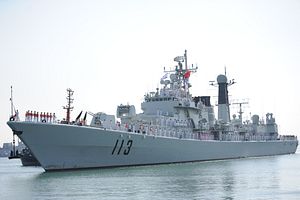Your recommended weekly defense and security links from around Asia:
China’s back in the East China Sea. After a period of relatively low military activity in the area, China carried out air and sea exercises in the East China Sea on Thursday, according to state news reports. The reports do not specify where exactly in the East China Sea the exercises took place. In the East China Sea, China disputes the sovereignty of the Senkaku/Diaoyu islands, which are administered by Japan. Recently, ahead of the release of its 2015 defense white paper, Tokyo drew attention to Chinese oil rig activity in the East China Sea, alleging that China was exploiting resources outside of the scope of a bilateral agreement for joint resource development.
Russia and China beef up their amphibious capabilities. Russia and China carried out their first-ever joint amphibious landing exercise. China’s Ministry of Defense published photographs of the exercise, which involved more than 400 marines, of which at least 100 were Chinese. Amphibious landing is one of the more challenging operations in the repertoire of any navy and joint coordination implies a high degree of cooperation between the two navies. Russia and China have been steadily ramping up the frequency and seriousness of their bilateral exercises. Their navies are also exercising in several geographic regions. While this amphibious landing exercise took place “in waters off Russia’s Clerk Cape as part of the ongoing Joint Sea-2015 (II) exercise between the two countries,” the two have exercise in the Mediterranean and plan to carry out exercises in the South China Sea next year as well.
Pakistan could field the third largest nuclear arsenal in the world. A new report authored by Michael Krepon and Toby Dalton, available here in PDF, grabbed headlines today for its provocative claim that Pakistan could soon emerge with the world’s third largest nuclear weapons arsenal. The whole report takes a nuanced look at the path Pakistan would have to pursue to emerge as a “normal” nuclear state. This is challenging for Islamabad given that it is not a signatory to the nuclear Non-proliferation Treaty (NPT). India, also a non-signatory, is a de facto normal nuclear state in the wake of its 2005 civil nuclear agreement with the United States, which, among other things, allowed New Delhi to received a waiver from the Nuclear Suppliers Group (NSG) in 2008. My colleague Prashanth Parameswaran has some insight from an event at the Stimson Center featuring the report’s authors–check that out here.
Twelve’s the magic word. We’ve discussed the debate in the United States, between the Pentagon and the White House, about the merits of the United States sending its military assets within 12 nautical miles of South China Sea territorial features that were previously low-tide elevations (specifically Mischief and Subi Reef) and, thus, under the United Nations Convention on the Law of the Sea, are entitled to no territorial sea. The Wall Street Journal revisits the issue, noting that sending U.S. assets within 12 nmi of “the artificial islands” would be equivalent to the U.S. flying B-52 bombers through China’s East China Sea air defense identification zone back in November 2013.
































